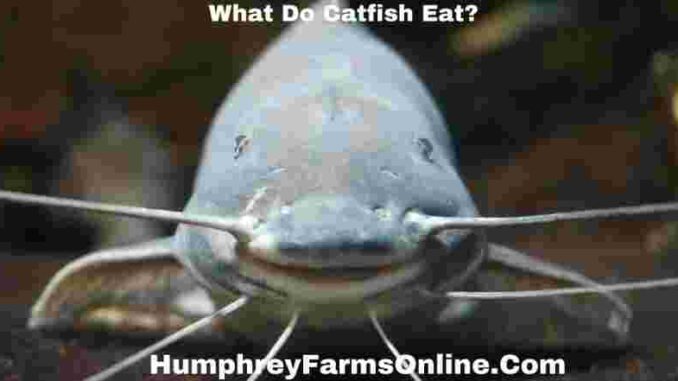
Understanding what catfish eat is crucial for both avid anglers and those interested in these fascinating fish.
Catfish are opportunistic feeders with a diverse diet, which can vary depending on their species, environment, and the availability of food.
In this article, we’ll explore the dietary habits of catfish and offer insights into the best bait options for successful fishing.
Catfish Eating Habits: An Overview
Catfish are versatile feeders that can consume a wide range of foods. Here’s a general look at their dietary habits:
- Opportunistic Feeders: Catfish will eat almost anything that comes their way, from live prey to decaying matter.
- Scavengers and Predators: They are both scavengers, feeding on dead or decomposing organic matter, and predators, hunting live prey.
What Do Different Catfish Species Eat?
The North American catfish family includes several species, each with its unique dietary preferences. Here’s a breakdown of what different catfish species eat:
Flathead Catfish
Flathead catfish are known for their predatory nature. Their diet primarily includes:
- Live Fish: Perch, bluegill, and other small fish.
- Large Prey: They can also consume fish as large as themselves, including bowfin.
- Non-Fish Items: Frogs, mice, and even ducklings. There have been reports of flatheads consuming unusual prey like baby squirrels.
Main Prey Items:
- Bass
- Bluegill and sunfish
- Carp and suckers
- Mudfish
- Shad
- White perch
Blue Catfish
Blue catfish are the largest of the North American catfish species and have a diverse diet, including:
- Live Fish: Small fish, including other catfish.
- Scavenged Items: Dead fish and invertebrates.
- Clams and Mussels: They are known to favor mollusks and asiatic clams in several watersheds.
Main Food Items:
- Amphibians and small reptiles
- Birds
- Clams and mussels
- Crayfish
- Shad
- Suckers
- Sunfish
Channel Catfish
Channel catfish are known for their omnivorous diet, which shifts as they grow:
- Young Channel Cats: Feed on aquatic insects, small invertebrates, and mollusks.
- Adult Channel Cats: Include more fish and crustaceans in their diet.
Favorite Food Sources:
- Aquatic insects and plants
- Crayfish
- Smaller fish
- Mollusks and snails
Bullhead Catfish
Bullhead catfish are smaller and more efficient scavengers:
- Bottom Feeders: They rummage through the substrate for food.
- Varied Diet: Includes aquatic plants, insects, and small fish.
Primary Diet:
- Aquatic plants
- Crayfish
- Insects and larvae
- Fish eggs
- Leeches
- Minnows
- Snails
Catfish Diet in Different Environments
Catfish adapt their diet based on their habitat and available food sources. Here’s how their diet changes depending on the environment:
- Rivers: Catfish often feed on drifting food items and can be seen holding in deep pools or slackwater eddies.
- Lakes and Ponds: They typically hunt along the bottom for food but may occasionally surface feed, especially at night.
- High-Water Events: Catfish may indulge in a feeding frenzy during times of high water flow.
The Role of Water Temperature
Water temperature significantly affects catfish feeding behavior:
- Warmer Water: Increases metabolism and feeding frequency. Catfish are more active and require more food.
- Colder Water: Slows metabolism and feeding activity. Catfish may move less and feed less frequently, relying on stored fat reserves.
Best Baits for Catfish
Choosing the right bait is crucial for catching catfish. Here are some effective bait options based on what catfish eat:
- Chicken Livers: A popular choice, especially for channel and bullhead catfish.
- Stinkbaits: Effective for channel catfish; the smellier, the better.
- Nightcrawlers: Suitable for bullhead and smaller catfish species.
- Live or Cut Bait: Ideal for larger catfish like flatheads and blues. Options include live bluegills, cut bait, and fresh bait from the target water body.
What Food Do Catfish Eat?
Catfish are fascinating creatures that thrive in a variety of freshwater environments across the globe. With over 3,000 species of catfish, each has unique dietary preferences influenced by their habitat, size, and life stage.
Understanding what catfish eat is crucial for those keeping them in aquariums or fishing for them. This guide explores the diverse diets of different types of catfish and provides insights into their feeding habits.
General Diet of Catfish
Catfish are versatile eaters, adapting their diet based on their surroundings and available food sources. Here’s a look at what they commonly consume:
- Small Fish: Minnows, shad, and other baby fish.
- Invertebrates: Bugs, larvae, worms, crayfish, and small shellfish like shrimp and clams.
- Amphibians: Tadpoles and frogs.
- Scavenging: Dead organisms at the bottom of lakes and rivers.
- Plant Matter: Occasionally, algae and bits of plants may be ingested incidentally.
In aquariums and fish farms, catfish are often fed specially formulated fish food to promote growth and health. Their diet can vary with size, habitat, and environmental conditions.
What Do Cory Catfish Eat?
Corydoras catfish, or Cory catfish, are small, peaceful freshwater fish popular in home aquariums. They are omnivores and have a diet that includes:
- Insects and Worms: Tiny insects and worms found at the bottom of their habitat.
- Plant Matter: Algae and blanched vegetables like zucchini and cucumber.
- Commercial Food: Sinking pellets, algae wafers, flake food, and frozen bloodworms.
These fish eat slowly, so it’s best to offer small portions multiple times a day to maintain water quality.
What Do Channel Catfish Eat?
Channel catfish are a popular game fish in North America, recognizable by their forked tails and slender bodies. Their diet includes:
- Live Bait: Small fish, insects, crustaceans, and nightcrawlers.
- Cut Bait and Commercial Food: Catfish pellets and other specially designed food.
- Occasional Fruits and Vegetables: Items like corn and watermelon.
For effective fishing, use strong-smelling bait and practice bottom-fishing techniques.
What Do Flathead Catfish Eat?
Flathead catfish, known for their broad mouths and flat heads, are aggressive carnivores. They primarily consume:
- Fish and Frogs: Live bait such as fish and frogs.
- Crustaceans and Insects: Protein-rich invertebrates.
- Cut Bait and Commercial Food: Also attracted to cut bait and specialized catfish food.
Anglers targeting flathead catfish should use heavy tackle and large bait to match their substantial size.
What Do Bullhead Catfish Eat?
Bullhead catfish, recognizable by their flat heads and spiky fins, are adaptable feeders. Their diet includes:
- Live Bait: Worms, insects, and nightcrawlers.
- Cut Bait and Commercial Pellets: Similar to Channel catfish.
- Occasional Fruits and Vegetables: They may also eat fruits and vegetables.
For fishing, worms or nightcrawlers work well, especially when fishing at the bottom where these catfish are most active.
What Do Blue Catfish Eat?
Blue catfish are among the largest catfish species in North America. Their diet is quite extensive and includes:
- Other Fish: Larger fish like catfish or carp.
- Mussels and Crayfish: Protein-rich aquatic organisms.
- Small Birds: Occasionally, they may consume small birds.
Fishing for blue catfish requires strong gear and thick lines due to their size and strength.
What Do Baby Catfish Eat?
Young catfish have specific dietary needs that evolve as they grow. Initially, they consume:
- Small Invertebrates: Insect larvae, tiny crustaceans, and small worms.
- Algae and Tiny Organisms: Protozoa and rotifers.
- Specialized Foods: In captivity, they may be fed liquid foods or crushed food designed for their size.
Maintaining clean water and providing appropriate food is essential for their healthy development.
How Do Catfish Find Their Food?
Catfish use a variety of sensory methods to locate food:
- Barbels: Whisker-like structures around their mouths that help them taste and feel their environment.
- Sense of Smell: Catfish can detect chemicals released by potential food, even in murky water.
- Vibrations: They can sense vibrations in the water to detect food sources.
- Sight: Although not their primary sense, catfish can use their vision to spot movement, especially in brighter conditions.
Diet of Catfish in Different Water Environments
The diet of catfish can vary significantly depending on their environment:
- Rivers and Streams: Small fish, insects, crayfish, and amphibians.
- Lakes and Ponds: Similar diet to rivers but also includes zooplankton and algae.
- Reservoirs: Predominantly small fish and baitfish.
- Fish Farms: Specially formulated catfish food.
The Impact of Water Temperature on Catfish Diet
Water temperature affects catfish feeding patterns in several ways:
- Metabolism: Warmer water speeds up metabolism, increasing their need for high-protein foods.
- Activity Level: Catfish are more active and seek food more aggressively in warmer temperatures.
- Food Availability: The abundance of prey changes with water temperature, affecting their diet.
- Digestion: Warmer water enhances digestion, allowing catfish to process nutrients more efficiently.
- Species Adaptations: Different catfish species have varying responses to temperature changes.
What is the Best Bait to Use for Catching Catfish?
Choosing the right bait depends on the type of catfish and local conditions. Here are some effective options:
- Live Bait: Minnows, shad, nightcrawlers, and worms.
- Cut Bait: Pieces of fish or chicken liver.
- Stink Bait: Strong-smelling substances that attract catfish from a distance.
- Commercial Catfish Baits: Specially formulated baits available in stores.
Experimenting with different baits can help you find what works best in your fishing area.
=================================================
Understanding what catfish eat is essential for both aquarium enthusiasts and anglers. By recognizing their dietary preferences and adjusting feeding or bait strategies accordingly, you can ensure the health of your catfish or improve your fishing success.
Whether you’re maintaining a tank or fishing in local waters, knowing the right food choices can make a significant difference.
FAQ
Do catfish eat every day?
Catfish don’t necessarily eat every day. Their feeding frequency depends on food availability, water temperature, and individual hunger levels.
What is the lifespan of a catfish?
Catfish can live for several years, with some species reaching 15-20 years in the wild. Lifespan varies with species and environmental conditions.
Conclusion
Catfish are opportunistic feeders with a diet that varies widely depending on species, environment, and available food sources.
By understanding what catfish eat and choosing the appropriate bait, you can increase your chances of a successful catch.
Whether you’re targeting flatheads, blues, channels, or bullheads, adapting your approach based on their dietary preferences will help you make the most of your fishing adventures.

Leave a Reply
You must be logged in to post a comment.